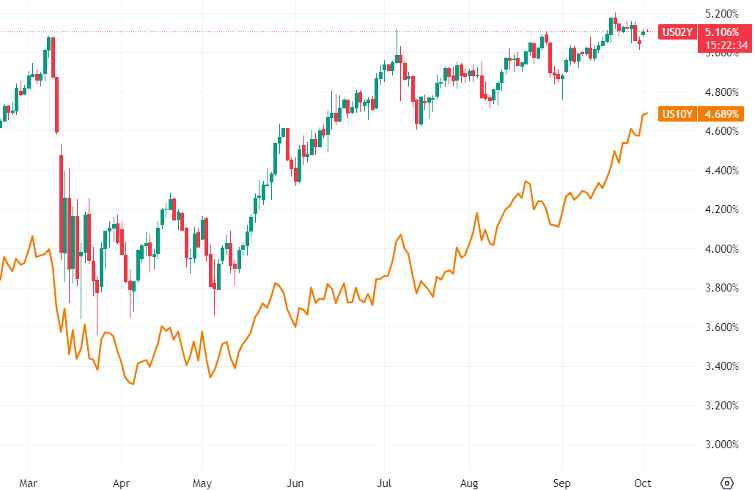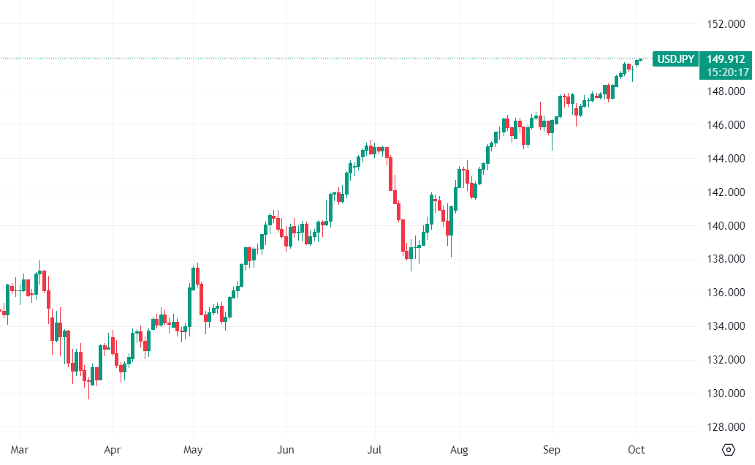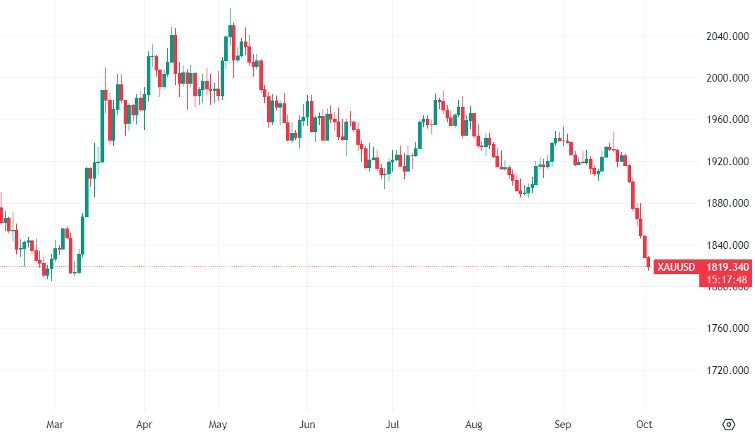Dow Drops as Treasury Yields Rise, Dollar Gains, and Gold Faces Pressure | Daily Market Analysis

Key events:
- Australia - RBA Interest Rate Decision (Oct)
- USA - JOLTs Job Openings (Aug)
On Monday, the Dow Jones Industrial Average closed lower, largely driven by declines in the energy and utilities sectors. This decline coincided with a continued rise in Treasury yields, following the US government's last-minute funding measure to avert a shutdown and keep the government funded for the next 45 days.
The Dow Jones Industrial Average saw a modest drop of 0.2%, equivalent to 74 points, while the Nasdaq experienced a 0.7% increase, and the S&P 500 remained relatively flat.

The surge in Treasury yields was prompted by increasing expectations of another Federal Reserve interest rate hike, which became more likely after the US government managed to avert a shutdown.
The 2-year Treasury yield climbed by 5.2 basis points to reach 5.098%, while the 10-year Treasury yield saw a substantial increase of 12 basis points, reaching 4.696%.

In response to the government's action, Congress passed a short-term funding measure extending government funding until November 1, effectively preventing the expected near-term economic growth setback associated with a government shutdown.
Notable stock movements included a 2.8% jump in Nvidia's (NASDAQ: NVDA) stock price, as Goldman Sachs added the chipmaker to its conviction list. Tesla (NASDAQ: TSLA) initially saw a 3% dip in its stock price but later recovered, closing up 0.5% despite missing market estimates for third-quarter deliveries.
In addition, several mega-cap stocks, including Apple (NASDAQ: AAPL), Meta Platforms (NASDAQ: META), Amazon.com (NASDAQ: AMZN), Alphabet (NASDAQ: GOOGL), and Microsoft (NASDAQ: MSFT), recorded gains ranging from 0.9% to 1.9%.
During a community roundtable discussion, Federal Reserve Chair Jerome Powell refrained from commenting on current monetary policy or the economic outlook during his brief opening remarks.
Meanwhile, Fed Governor Michelle Bowman expressed her willingness to support another increase in the central bank's policy interest rate at a future meeting if incoming data suggests that progress on inflation is either stalling or proceeding too slowly.

Earlier on Monday, the US dollar reached a 10-month peak when measured against a basket of major currencies. This surge was driven by the US government's successful avoidance of a partial shutdown and reinforced by economic data that heightened expectations of the Federal Reserve prolonging higher interest rates, potentially leading to a deceleration in economic growth.
Traders are closely monitoring the possibility of Japanese currency intervention as the yen inches closer to the 150-per-dollar mark. The yen is currently under pressure from a robust dollar, which has reached a new 10-month high against other major currencies.

In the meantime, Australia's central bank has maintained its interest rates at the current level for the fourth consecutive month. However, the bank reiterated its caution that additional tightening measures may be necessary to effectively manage inflation within a "reasonable timeframe."
European markets had a challenging start to both the new quarter and the week, influenced by rising yields and a stronger US dollar, which kept investors cautious.
The FTSE100, in particular, experienced a disappointing day, slipping below the low point of the previous week to reach its lowest level since September 13th. Across the board, all sectors saw negative performance. Similar price movements were observed in Asian markets, where the Nikkei 225 dropped to its lowest point in four months. This weakness appears likely to continue in European markets, maintaining the negative sentiment from the previous day and leading to a lower opening.

However, there is a glimmer of hope that these challenges may be subsiding, as suggested by yesterday's ISM manufacturing survey for September. The data indicated a slowdown in prices paid and an increase in hiring, potentially signaling a positive trend. The various job-related data releases scheduled for this week aim to provide further support to this evolving narrative.
Gold is facing significant pressure from surging bond yields, resulting in the precious metal experiencing another 1% decline yesterday. This decline is exacerbated by the strength of the US dollar. The next substantial support level for gold is approximately $1,800, but if bond yields continue their upward trajectory, this support may prove to be fragile. It's important to note that while the persistence of rising yields is uncertain, the recent trajectory for gold has undeniably been marked by bearishness and aggressive selling.

Today's JOLTS report for August is anticipated to reveal that vacancy rates remained steady at 8.83 million, unchanged from July, highlighting the resilience of the US labor market.










